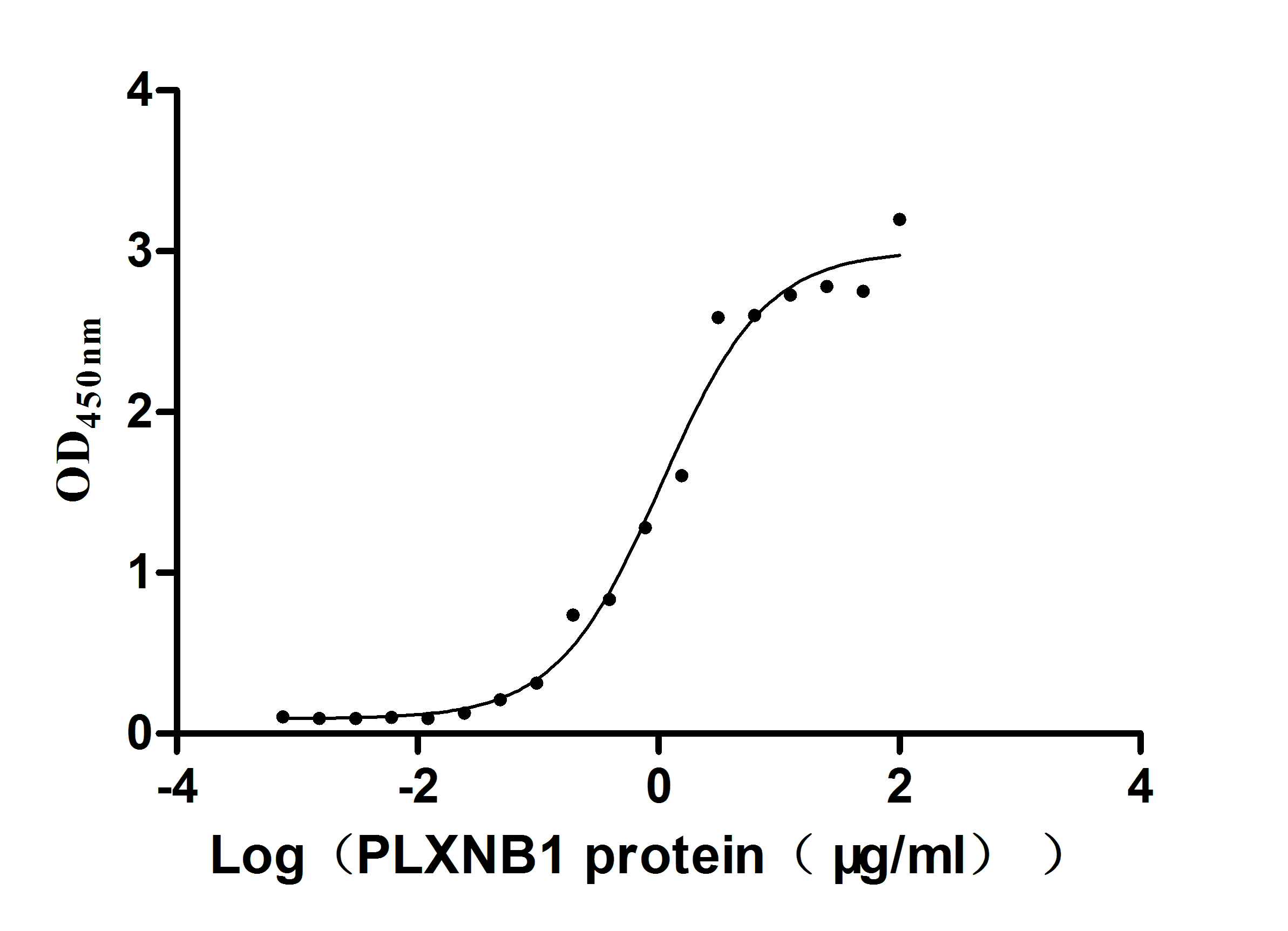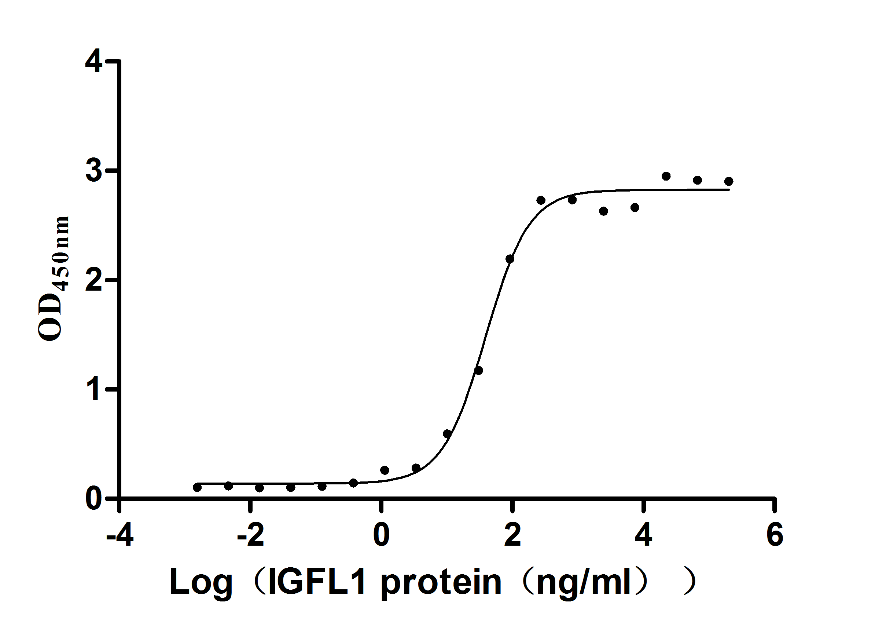Recombinant Human Tripeptidyl-peptidase 1 (TPP1)
-
货号:CSB-YP024113HU
-
规格:
-
来源:Yeast
-
其他:
-
货号:CSB-EP024113HU
-
规格:
-
来源:E.coli
-
其他:
-
货号:CSB-EP024113HU-B
-
规格:
-
来源:E.coli
-
共轭:Avi-tag Biotinylated
E. coli biotin ligase (BirA) is highly specific in covalently attaching biotin to the 15 amino acid AviTag peptide. This recombinant protein was biotinylated in vivo by AviTag-BirA technology, which method is BriA catalyzes amide linkage between the biotin and the specific lysine of the AviTag.
-
其他:
-
货号:CSB-BP024113HU
-
规格:
-
来源:Baculovirus
-
其他:
-
货号:CSB-MP024113HU
-
规格:
-
来源:Mammalian cell
-
其他:
产品详情
-
纯度:>85% (SDS-PAGE)
-
基因名:
-
Uniprot No.:
-
别名:Cell growth inhibiting gene 1 protein; Cell growth-inhibiting gene 1 protein; Ceroid lipofuscinosis neuronal 2; Ceroid lipofuscinosis neuronal 2 late infantile (Jansky Bielschowsky disease); Ceroid lipofuscinosis neuronal 2 late infantile; CLN 2; CLN2; GIG 1; GIG1; Growth inhibiting protein 1; LPIC; Lysosomal pepstatin insensitive protease; Lysosomal pepstatin-insensitive protease; MGC21297; TPP 1; TPP I; TPP-1; TPP-I; Tpp1; TPP1_HUMAN; TPPI; Tripeptidyl aminopeptidase; Tripeptidyl peptidase I; Tripeptidyl-peptidase 1; Tripeptidyl-peptidase I
-
种属:Homo sapiens (Human)
-
蛋白长度:Full Length of Mature Protein
-
表达区域:196-563
-
氨基酸序列LHLGV TPSVIRKRYN LTSQDVGSGT SNNSQACAQF LEQYFHDSDL AQFMRLFGGN FAHQASVARV VGQQGRGRAG IEASLDVQYL MSAGANISTW VYSSPGRHEG QEPFLQWLML LSNESALPHV HTVSYGDDED SLSSAYIQRV NTELMKAAAR GLTLLFASGD SGAGCWSVSG RHQFRPTFPA SSPYVTTVGG TSFQEPFLIT NEIVDYISGG GFSNVFPRPS YQEEAVTKFL SSSPHLPPSS YFNASGRAYP DVAALSDGYW VVSNRVPIPW VSGTSASTPV FGGILSLINE HRILSGRPPL GFLNPRLYQQ HGAGLFDVTR GCHESCLDEE VEGQGFCSGP GWDPVTGWGT PNFPALLKTL LNP
-
蛋白标签:Tag type will be determined during the manufacturing process.
The tag type will be determined during production process. If you have specified tag type, please tell us and we will develop the specified tag preferentially. -
产品提供形式:Lyophilized powder
Note: We will preferentially ship the format that we have in stock, however, if you have any special requirement for the format, please remark your requirement when placing the order, we will prepare according to your demand. -
复溶:We recommend that this vial be briefly centrifuged prior to opening to bring the contents to the bottom. Please reconstitute protein in deionized sterile water to a concentration of 0.1-1.0 mg/mL.We recommend to add 5-50% of glycerol (final concentration) and aliquot for long-term storage at -20℃/-80℃. Our default final concentration of glycerol is 50%. Customers could use it as reference.
-
储存条件:Store at -20°C/-80°C upon receipt, aliquoting is necessary for mutiple use. Avoid repeated freeze-thaw cycles.
-
保质期:The shelf life is related to many factors, storage state, buffer ingredients, storage temperature and the stability of the protein itself.
Generally, the shelf life of liquid form is 6 months at -20°C/-80°C. The shelf life of lyophilized form is 12 months at -20°C/-80°C. -
货期:Delivery time may differ from different purchasing way or location, please kindly consult your local distributors for specific delivery time.Note: All of our proteins are default shipped with normal blue ice packs, if you request to ship with dry ice, please communicate with us in advance and extra fees will be charged.
-
注意事项:Repeated freezing and thawing is not recommended. Store working aliquots at 4°C for up to one week.
-
Datasheet :Please contact us to get it.
相关产品
靶点详情
-
功能:Lysosomal serine protease with tripeptidyl-peptidase I activity. May act as a non-specific lysosomal peptidase which generates tripeptides from the breakdown products produced by lysosomal proteinases. Requires substrates with an unsubstituted N-terminus.
-
基因功能参考文献:
- The reports the crystal structure of the N-terminal domain of TIN2 in complex with TIN2-binding motifs from TPP1 and TRF2, revealing how TIN2 interacts cooperatively with TPP1 and TRF2. PMID: 29160297
- TPP1 cleaves and destabilizes fibrillar amyloid-beta at multiple sites in a time- and pH-dependent manner. PMID: 29378960
- To confirm clinical suspicion of CLN2 disease, the recommended gold standard for laboratory diagnosis is demonstration of deficient TPP1 enzyme activity (in leukocytes, fibroblasts, or dried blood spots) and the identification of causative mutations in each allele of the TPP1/CLN2 gene. PMID: 27553878
- These studies indicate that optimal treatment outcomes for CLN2 disease may require delivery of TPP1 systemically as well as directly to the central nervous system. PMID: 28079862
- TPP1 is overexpressed in hepatocellular carcinoma tissues and significantly correlated with poor prognosis of hepatocellular carcinoma patients.RFX5 acts as a direct positive transcriptional regulator of TPP1 in hepatocellular carcinoma. PMID: 27840983
- TPP1(CLN2) mutation is associated with neuronal ceroid lipofuscinosis. PMID: 24271013
- To our knowledge, our results bring the first evidence of a mechanism that links TPP-1 deficiency and oxidative stress-induced changes in mitochondrial morphology. PMID: 23249249
- hypothesize that loss of function variants abolishing TPP1 enzyme activity lead to CLN2 disease, whereas variants that diminish TPP1 enzyme activity lead to SCAR7 PMID: 23418007
- This study demonistrated that the CLN2 gene 4 mutation in late infantile neuronal ceroid lipofuscinosis. PMID: 22832778
- TPP1 mutants utilize the advantages of a zebrafish model for understanding the pathogenesis of late infantile (or classic late infantile neuronal ceroid lipofuscinosis) disease. PMID: 23587805
- The variant juvenile phenotype comprises approximately 50% of CLN2 in South America. The five most frequent South American mutations comprise 66% of pathological alleles. PMID: 23266810
- Gemfibrozil and fenofibrate, Food and Drug Administration-approved lipid-lowering drugs, up-regulate tripeptidyl-peptidase 1 in brain cells via peroxisome proliferator-activated receptor alpha and may have implications in late infantile Batten disease therapy PMID: 22989886
- Studies indicate that TPP-I is the only member of the sedolisin family that has been shown to exhibit tripeptidyl peptidase activity and is related to the fatal hereditary disease, Batten disease. PMID: 22016395
- Intrathecal human tripeptidyl-peptidase 1 administration reduces lysosomal storage in a canine model of late infantile neuronal ceroid lipofuscinosis. PMID: 21784683
- the critical residues in the TPPI catalysis and its structure-function analysis PMID: 20689811
- Data show that most TPPI variants displayed obstructed transport to the lysosomes. PMID: 20340139
- The s conducted a phase I study of late infantile neuronal ceroid lipofuscinosis using an adenoassociated virus serotype 2 (AAV2) vector containing the deficient CLN2 gene (AAV2(CU)hCLN2). PMID: 20672930
- The clinical, biochemical, and molecular genetic aspects of lysosomal storage disorders are discussed in this review PMID: 12125808
- Data show that three neuronal ceroid lipofuscinoses disease forms with similar tissue pathology are connected at the molecular level: CLN5 polypeptides directly interact with the CLN2 and CLN3 proteins PMID: 12134079
- Missense mutations, R127Q, N286S, and T353P represent novel, previously not described alleles. PMID: 12376936
- human tripeptidyl-peptidase I is processed by a serine protease to the mature, active form in vivo PMID: 12488460
- a novel mutation in neuronal ceroid lipofuscinosis PMID: 12698559
- CLN2 gene mutations may result in low cerebrospinal fluid pterin production in classical neuronal ceroid lipofuscinoses of late infantile onset. PMID: 12950156
- human tripeptidyl-peptidase I must be N-glycosylated for folding, trafficking, and stability PMID: 14702339
- mutant Asn286Ser CLN2 lacks one oligosaccharide chain resulting in enzymatic inactivation PMID: 14736728
- intramolecular (unimolecular) mechanism of TPP I activation and autoprocessing PMID: 15143070
- TPP-I is the predominant proteolytic enzyme responsible for the intracellular degradation of neuromedin B PMID: 15158442
- Functional analyses of CLN2 mutations reveal transport disruption of tripeptidyl-peptidase I to lysosomes. PMID: 15317752
- tripeptidyl-peptidase I activation, activity, and stability are regulated by glycosaminoglycans PMID: 15582991
- Ser475 and Asp360, also Glu272, Asp276, and Asp327 are important for catalytic activity of tripeptidyl peptidase I PMID: 15733845
- Substrate-binding cleft of TPP-I composed of only 6 subsites; TPP-I prefers bulky and hydrophobic amino acid residues at P(1) position and Ala, Arg, or Asp at P(2) position; hydrophilic interactions at the S(2) subsite are necessary for TPP-I. PMID: 16091586
- Mutational screening of CLCN2 gene, revealed a homozygous mutation G2003C (exon 17), leading to a Ser/Thr substitution at the codon 668, in two of the three in malignant migrating partial seizures patients. PMID: 16168594
- there is a close correlation between CLN2 and CLN1 expression and colorectal carcinoma progression and metastasis and suggest that they may be potential molecular targets PMID: 16518810
- Clinical features, histological findings, and genetic study reveal that CLN2 type is the most common form of neuronal ceroid lipofuscinosis. There is male predominance of 90.1% in this part of the Arab world. PMID: 17690061
- CLN2/TPP1 deficiency: the novel mutation IVS7-10A>G causes intron retention and is associated with a mild disease phenotype. PMID: 17959406
- the tripeptidyl peptidase I prosegment is a potent, slow-binding inhibitor of its cognate enzyme PMID: 18411270
- Lysosome-related genes, such as CLN2, CLN3, and HEXB, may be involved in the pathogenesis of adipose tissue hypertrophy in TED. PMID: 18552385
- Structure of tripeptidyl-peptidase I provides insight into the molecular basis of late infantile neuronal ceroid lipofuscinosis. PMID: 19038966
- Crystal structure and autoactivation pathway of the precursor form of human tripeptidyl-peptidase 1, the enzyme deficient in late infantile ceroid lipofuscinosis PMID: 19038967
- This novel deletion mutation in the CLN2 gene in a family of Arab origin from Israel sheds further light on the epidemiology of neuronal ceroid lipofuscinosis as a worldwide disease PMID: 19748052
- functional analysis of variants expressed in CHO cells PMID: 11462245
显示更多
收起更多
-
相关疾病:Ceroid lipofuscinosis, neuronal, 2 (CLN2); Spinocerebellar ataxia, autosomal recessive, 7 (SCAR7)
-
亚细胞定位:Lysosome. Melanosome.
-
组织特异性:Detected in all tissues examined with highest levels in heart and placenta and relatively similar levels in other tissues.
-
数据库链接:
HGNC: 2073
OMIM: 204500
KEGG: hsa:1200
STRING: 9606.ENSP00000299427
UniGene: Hs.523454
Most popular with customers
-
Recombinant Human Plexin-B1 (PLXNB1), partial (Active)
Express system: Mammalian cell
Species: Homo sapiens (Human)
-
Recombinant Human IGF-like family receptor 1 (IGFLR1), partial (Active)
Express system: Mammalian cell
Species: Homo sapiens (Human)
-
Recombinant Human Somatostatin receptor type 2 (SSTR2)-VLPs (Active)
Express system: Mammalian cell
Species: Homo sapiens (Human)
-
Recombinant Human Myosin regulatory light polypeptide 9 (MYL9) (Active)
Express system: Yeast
Species: Homo sapiens (Human)
-
Recombinant Rat Gastric inhibitory polypeptide receptor (Gipr), partial (Active)
Express system: Mammalian cell
Species: Rattus norvegicus (Rat)
-
Recombinant Mouse Cytotoxic and regulatory T-cell molecule (Crtam), partial (Active)
Express system: Mammalian cell
Species: Mus musculus (Mouse)
-
Recombinant Human Myosin regulatory light chain 12A (MYL12A) (Active)
Express system: E.coli
Species: Homo sapiens (Human)
-
Recombinant Human CD70 antigen (CD70), partial (Active)
Express system: Mammalian cell
Species: Homo sapiens (Human)




















